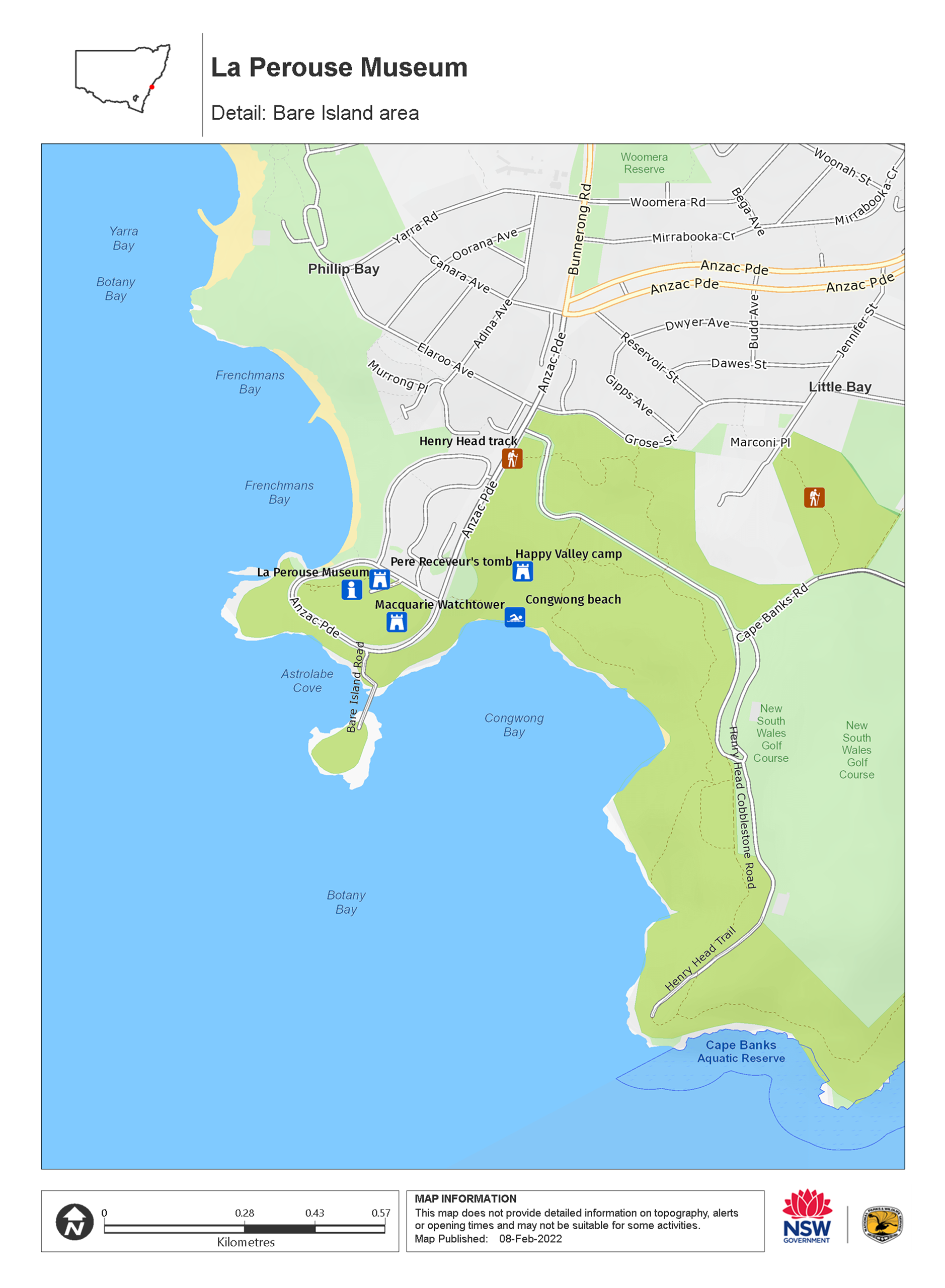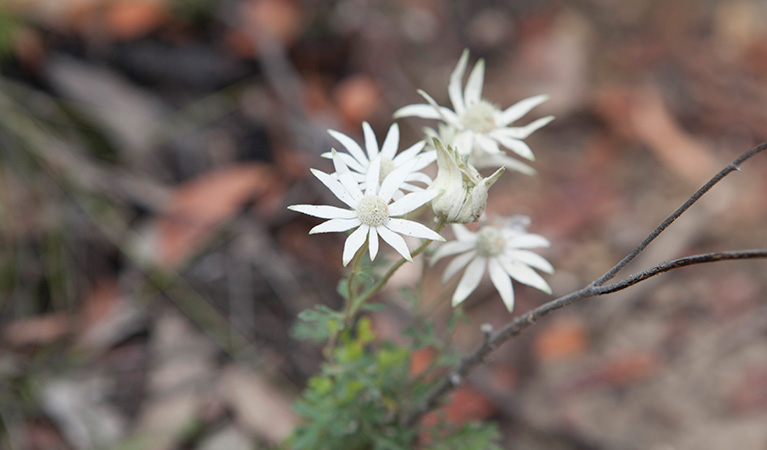La Perouse Museum
La Perouse area in Kamay Botany Bay National Park
Overview
Housed in a heritage building at La Perouse in Sydney's south, the La Perouse Museum documents the expedition of French explorer the Comte de Laperouse.
- Type
- Visitor centres
- Where
- 1542 Anzac Parade, La Perouse, NSW, 2036 - in La Perouse area in Kamay Botany Bay National Park in Sydney and surrounds
- Accessibility
- Hard
- Opening times
Wednesdays and Fridays, 10am to 2pm. Saturdays and Sundays, 10am to 4pm. Closed Christmas Day and New Year's Day.
- Please note
For more information visit the Randwick City Council website.
La Perouse Museum is located on Kamay Botany Bay National Park’s northern headland. The museum is housed within the historic Cable Station building, once Australia’s only link to the rest of the world. The La Perouse Monument is located nearby.
Almost 2,000 items across several rooms of exhibits document the 1787–1788 expedition of French explorer the Comte de Lapérouse. Items include the complete Atlas of the Voyage of La Perouse.
Lapérouse arrived in Botany Bay a week after the First Fleet. His expedition was last seen in what is now national parkland before mysteriously vanishing.
The fascinating exhibits in La Perouse Museum also tell stories of the local area, including Aboriginal stories.
Close to
-

Macquarie Watchtower
Macquarie Watchtower is in the La Perouse area of Kamay Botany Bay National Park, next to La Perouse Museum. Visit this historic stone building to learn about Sydney’s colonial and convict past.
-

Pere Receveurs Tomb
Pere Receveurs Tomb is in the La Perouse area of Kamay Botany Bay National Park, next to La Perouse Museum. This memorial marks the grave of French priest Pere le Receveur, of the ill-fated La Perouse expedition.
Map

Map legend

Local alerts
For the latest updates on fires, closures and other alerts in this area, see https://www.nationalparks.nsw.gov.au/things-to-do/visitor-centres/la-perouse-museum/local-alerts
Park info
- in the La Perouse area of Kamay Botany Bay National Park in the Sydney and surrounds region
7am–8.30pm November to March.
7am–7.30pm April to October.
La Perouse park entry gate closed to vehicles between 7pm and 5am all year.
Areas may have to close at times due to poor weather or fire danger.
-
There are no park entry fees in La Perouse area but you'll need to pay to tour Bare Island. Park entry fees apply in the Kurnell area of Kamay Botany Bay National Park, only.
Buy annual pass.
Visitor info
All the practical information you need to know about La Perouse Museum.
Maps and downloads
Learn more
La Perouse Museum is in La Perouse area. Here are just some of the reasons why this park is special:
Aboriginal culture

At the time of the first encounters with Europeans, Aboriginal people of 2 different nations - the Goorawal People and the Gweagal People - were living in the area which now includes Kamay Botany Bay National Park. Over 30 Aboriginal sites have been recorded in the park, including rock art and engravings.
- Blak Markets at Bare Island Visit Blak Markets at La Perouse, to discover the best of Aboriginal culture. There'll be traditional dance performances, arts and craft stalls, weaving and bush tucker.
- Dharawal Resting Place track Walk the short track to Dharawal Resting Place to discover this important La Perouse Aboriginal site, that’s also steeped in Sydney’s colonial history.
Sharing traditional knowledge

The Gamay Rangers have been appointed as ‘honorary rangers’ for Kamay Botany Bay National Park. Part of the Commonwealth Indigenous Ranger Program, which is designed to support Indigenous Australians to protect and conserve land and sea Country, the Gamay Rangers work alongside the NSW National Parks and Wildlife Service. The Gamay team share traditional knowledge and techniques, and are involved in the management of natural and cultural resources, protection of marine wildlife, and operation of the national parks on their cultural areas.
- Blak Markets at Bare Island Visit Blak Markets at La Perouse, to discover the best of Aboriginal culture. There'll be traditional dance performances, arts and craft stalls, weaving and bush tucker.
- Dharawal Resting Place track Walk the short track to Dharawal Resting Place to discover this important La Perouse Aboriginal site, that’s also steeped in Sydney’s colonial history.
Historic heritage

Two of Australia's earliest European explorers landed in Botany Bay here—James Cook in 1770, and the Comte de Laperouse in 1788. Cook's botanists, Joseph Banks and Daniel Solander, first explored Australia's natural world here. After the reports of Cook and Banks, Botany Bay was recommended as a suitable site for settlement. But upon inspection by Captain Arthur Phillip it was found unsuitable as it had no secure fresh water or suitable anchorage. Sydney Cove was set up as the penal colony instead. You can also explore the fascinating history of Bare Island Fort on a guided tour, see World War II military remnants at Henry Head, or learn more at La Perouse Museum.
- Bound for Botany Bay In 1770, James Cook and his crew aboard the Endeavour were bound for Botany Bay. Their 8-day stay would have a dramatic impact on the future of Australia. This Stage 2 (Years 3-4) History excursion explores the first British landing on Australian soil.
- Cape Banks walking track Cape Banks walking track is a beautiful coastal walk in La Perouse with views across Sydney’s Botany Bay. Start at Congwong Beach and take a swim along the way before passing Henry Head. Continue to Cape Banks, a fantastic spot for whale watching.
- Dharawal Resting Place track Walk the short track to Dharawal Resting Place to discover this important La Perouse Aboriginal site, that’s also steeped in Sydney’s colonial history.
- Junior ranger: Bound for Botany Bay Want to discover what life was like for a convict in Sydney? These school holidays, come to Bare Island at La Perouse, and find out more in this fun junior ranger event for kids aged 6 to 12 years.
- La Perouse Museum Housed in a heritage building at La Perouse in Sydney's south, the La Perouse Museum documents the expedition of French explorer the Comte de Laperouse.
Biodiversity

Much of the park’s unspoilt flora give an idea of the plants that were present pre-1770. A conservation effort to protect and rehabilitate rare and threatened species and ecosystems is underway to preserve this heritage-listed Sydney park. Henry Head walking track leads through the rare eastern suburbs banksia scrub now listed as an endangered ecological species.
- Cape Banks walking track Cape Banks walking track is a beautiful coastal walk in La Perouse with views across Sydney’s Botany Bay. Start at Congwong Beach and take a swim along the way before passing Henry Head. Continue to Cape Banks, a fantastic spot for whale watching.
- Jennifer Street boardwalk Jennifer Street boardwalk is a short, wheelchair-accessible walking track in La Perouse. The smooth, boarded path is popular with all ages looking for an easy weekend walk in Sydney.
Visitor experiences

La Perouse offers a real escape just minutes from the city and close to cafes and public transport. Take a day trip to go bushwalking, whale watching or fishing. Learn more about the early European explorers, and Aboriginal stories, at the fascinating exhibits in La Perouse Museum tell. Enjoy a picnic, cafes and fish ’n’ çhips and watch the sun set over the bay. Keep an eye out for guided tours of Bare Island Fort.
Plants and animals protected in this park
Animals
-

White-bellied sea eagle (Haliaeetus leucogaster)
White-bellied sea eagles can be easily identified by their white tail and dark grey wings. These raptors are often spotted cruising the coastal breezes throughout Australia, and make for some scenic bird watching. Powerful Australian birds of prey, they are known to mate for life, and return each year to the same nest to breed.
Plants
-

Blueberry ash (Elaeocarpus reticulatus)
The blueberry ash is a rainforest shrub which produces blue olive-shaped berries and spectacular bell-shaped flowers, which often appear on the plant together. It is a tall slender shrub or small tree found in rainforest, tall eucalypt forest and coastal bushland in eastern NSW, south-east Queensland and Victoria.
-

Flannel flower (Actinotus helianthi)
The delicate flannel flower is so named because of the soft woolly feel of the plant. Growing in the NSW south coast region, extending to Narrabri in the Central West and up to south-east Queensland, its white or pink flowers bloom all year long, with an extra burst of colour in the spring.
-

Old man banksia (Banksia serrata)
Hardy Australian native plants, old man banksias can be found along the coast, and in the dry sclerophyll forests and sandstone mountain ranges of NSW. With roughened bark and gnarled limbs, they produce a distinctive cylindrical yellow-green banksia flower which blossoms from summer to early autumn.
-

Smooth-barked apple (Angophora costata)
Smooth-barked apple gums, also known as Sydney red gum or rusty gum trees, are Australian native plants found along the NSW coast, and in the Sydney basin and parts of Queensland. Growing to heights of 15-30m, the russet-coloured angophoras shed their bark in spring to reveal spectacular new salmon-coloured bark.

